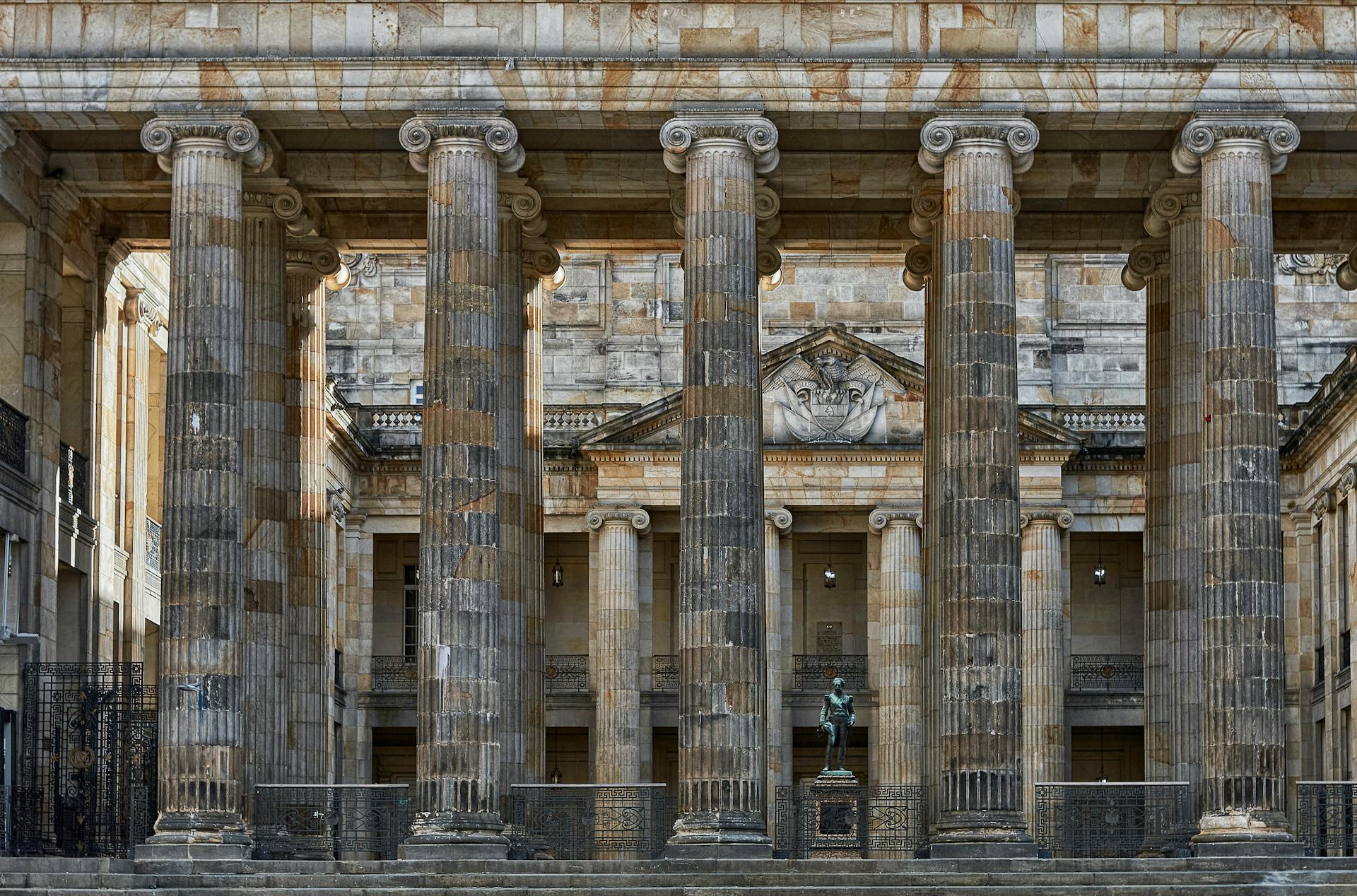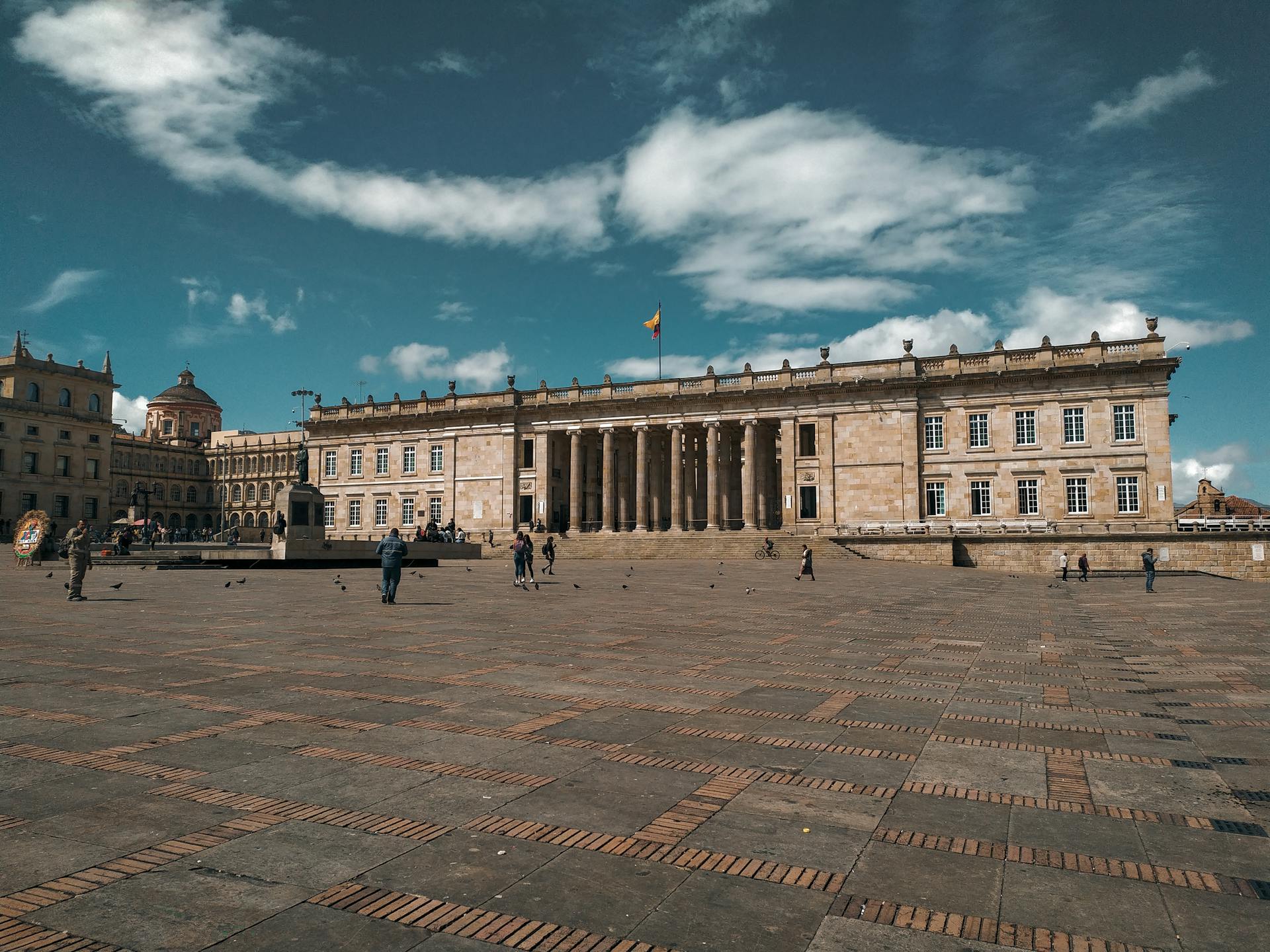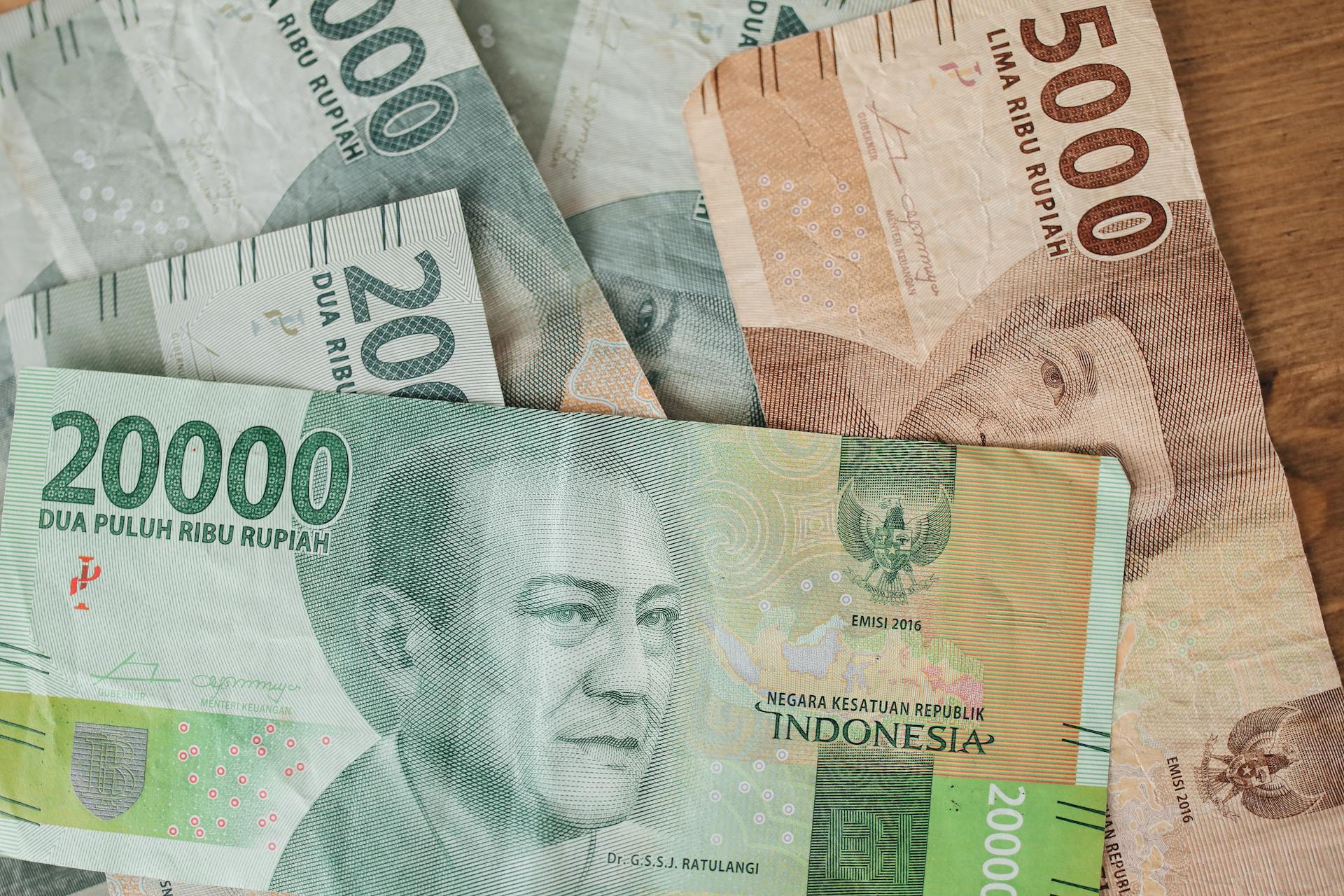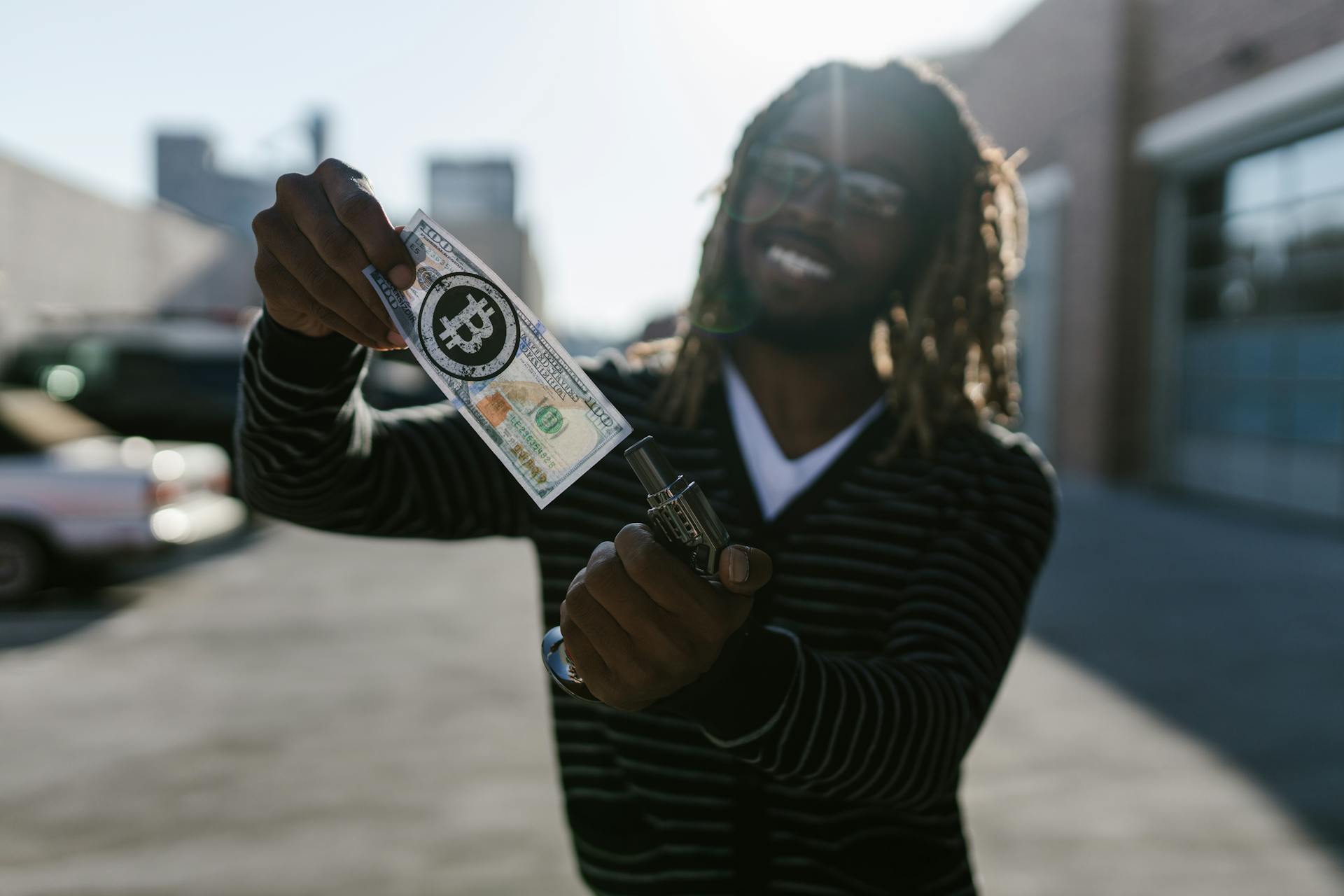
The Bolivar currency has a rich history, with its origins dating back to 1810.
The Bolivar was first introduced as a replacement for the Spanish real, which was the official currency of Venezuela at the time.
In 2008, the Bolivar Fuerte was introduced, replacing the old Bolivar at a rate of 1000 to 1.
Today, the Bolivar is the official currency of Venezuela, with the Bolivar Soberano (VES) being the current version.
For your interest: Venezuela Currency to Gbp
History of Bolivar
The Venezuelan bolivar has a complex and tumultuous history, with significant fluctuations in its value over the years. In 2012, the exchange rate was around 10 hard bolivars (Bs.F) to 1 US dollar.
The government introduced a new currency, the sovereign bolivar (Bs.S), in 2018, which was pegged at 100,000 hard bolivars to 1 sovereign bolivar. This move was an attempt to stabilize the economy, but it ultimately led to more inflation and a further devaluation of the currency.
For your interest: Buy Bolivars
By 2021, the exchange rate had reached an astonishing 1.8 million hard bolivars to 1 US dollar, with some months seeing rates as high as 2.1 million. This extreme volatility has made it difficult for Venezuelans to access basic goods and services, exacerbating the country's economic crisis.
Here's a brief timeline of the bolivar's decline:
Pre-Independence
Before Venezuela gained independence, the country's currency was based on the Spanish-American monetary system. This system used the silver peso and the gold escudo, with the peso being equivalent to 8 reales.
The peso was divided into smaller units, but we don't have specific information on the denominations used during this time. However, we do know that the Guipuzcoana Company brought in a large quantity of cobs (macuquina) from the Lima, Potosí, and Mexico City mints, which remained the coinage in circulation for many years.
Venezuela's first mint opened at Caracas in November 1802, marking a significant step towards a more regulated and official currency system. The mint initially produced official copper tokens, which were authorized by the Caracas Cabildo.
Here's a list of some of the copper tokens produced by the mint:
- 1/8r (7,000)
- 1/4r (30,000)
These tokens were used to facilitate retail trade, which was a significant issue in Venezuela at the time due to an inadequate money supply.
1879-1887 (Silver)
The Venezuelan bolívar was introduced in 1879 as a replacement for foreign coin in circulation. The bolívar de plata was the basic monetary unit, obligatory from July 1, 1879.
Gen. Guzmán Blanco returned to power in 1879 and continued his 1871 program to replace foreign coin with a national coinage. His monetary law of March 31, 1879 was based on the principles of the Latin Monetary Union.
Coins produced in Brussels and dated 1879 were put into circulation between November 1879 and October 1880. Postage stamps appeared in January 1880 in denominations of 5, 10, 25, and 50 céntimos and 1, 2, 5, 10, 20, and 25 bolívares.
A modern, national mint was finally inaugurated at Caracas on October 16, 1886. The import of foreign coin was then prohibited.
Here's a breakdown of the silver bolívar coins produced between 1879 and 1889:
The 5 bolívares dated 1879-1889 has "28 DE MARZO DE 1864" in the ribbon (reverse).
1887–1930 (Gold)

The gold standard was established in Venezuela in 1865, but it took a while for the country to get its coinage system up and running.
Peso fuerte, or Venezolano de oro, was the official currency, equivalent to 10 Reales or 100 Centavos.
In 1865, the proposed gold coins were 0·900 fine, with a peso fuerte or Venezolano de oro weighing 1·612 g.
The economic situation was unfavorable, and it proved impossible to erect a mint at this time.
Foreign coins were given new ratings, and the currency in circulation was generally in poor condition.
A copper centavo of 8·00 g was also introduced as a subsidiary coin.
The Banco de Maracaibo was founded in 1882 as a merchant bank without any links to the government.
It began issuing notes in 1883 for 20, 50, and 100 bolívares.
Check this out: Philippines Currency 100
1944-1948 Issues
Between 1944 and 1948, the Bolivar issues experienced significant changes.
The 5c coin was produced in two different quantities during this period. In 1945 and 1946, 12 million coins were minted each year, while in 1948, 18 million coins were produced.

The 12½c coin also had varying production numbers. In 1945, 11.2 million coins were made, followed by 9.2 million in 1946 and 6 million in 1948.
The 25c type 1894 coin, made of 0.835 fine silver, was produced in three different quantities. In 1944, 1.807 million coins were minted, while in 1946 and 1948, 8.007 million and 8.64 million coins were produced, respectively.
The 50c coin was also produced during this time, with 0.5 million coins made in 1944, 4 million in 1945, and 2.5 million in 1946.
Here's a summary of the production numbers for the 25c type 1894, 50c, Bs. 1, and Bs. 2 coins:
1954-1965 Issues
During the 1954-1965 period, the Bolivar coinage underwent significant changes. The inscription on the coinage was changed to República de Venezuela.
The 5c and 12½c coins were redesigned with a new diameter and weight. The 5c coin was 19 mm in diameter and weighed 2.500 g, while the 12½c coin was 23 mm in diameter and weighed 5.00 g.
Silver 0.835 fine coins were also introduced during this period. The 25c, 50c, and Bs. 1 coins were minted with a specific weight and diameter. The 25c coin was 16 mm in diameter and weighed 1.250 g, while the 50c coin was 18 mm in diameter and weighed 2.500 g.
Here's a breakdown of the silver coins minted during this period:
The Bs. 1 and Bs. 2 coins were also minted in large quantities during this period, with the Bs. 1 coin being minted over 60 million times.
1988-1990 Issues
During the 1988-1990 period, the Bolivar currency underwent significant changes with the introduction of new coins.
The 25c coin, measuring 17 mm in diameter and weighing 1.500 g, was produced in large quantities, with 510 million coins minted in 1989 and 400 million in 1990.
The 50c coin, measuring 20 mm in diameter and weighing 3.500 g, also saw significant production, with 80 million coins minted in 1988, followed by 260 million in 1989 and 300 million in 1990.
Readers also liked: 500 Bolivares a Dolares

The Bs. 1 coin, measuring 23 mm in diameter and weighing 5.000 g, was another widely produced coin, with 370 million minted in 1989 and 600 million in 1990.
The Bs. 2 coin, measuring 27 mm in diameter and weighing 8.500 g, was produced in varying quantities, with 200 million minted in 1989 and 100 million in 1990.
The Bs. 5 coin, measuring 31 mm in diameter and weighing 13.300 g, had a production run of 176 million in 1989 and 200 million in 1990.
Here's a summary of the 1988-1990 coin production:
Venezolano (1871-1879)
The Venezuelan era, also known as the Venezolano period, was a pivotal time in Bolivar's life.
During this time, from 1871 to 1879, Bolivar's health began to decline significantly.
He suffered from a range of ailments, including stomach problems and respiratory issues.
Bolivar's health issues made it difficult for him to continue his military campaigns.
As a result, he was forced to rely on his allies to carry out many of his military plans.
Despite his health struggles, Bolivar remained committed to his vision for a unified Venezuela.
He continued to work tirelessly, albeit from a distance, to achieve his goals.
Bolivar's leadership during this period was instrumental in shaping the country's future.
His legacy as a unifying force in Venezuela's history was cemented during this time.
Bolivar Types
There are several types of Bolivar currencies, each with its own unique characteristics.
The Bolivar Fuerte, introduced in 2008, was a replacement for the old Bolivar and was subdivided into 100 centimos.
The Bolivar Soberano, introduced in 2018, is the current currency and is also subdivided into 100 centimos, making it a direct replacement for the Bolivar Fuerte.
Venezolano de Oro (Gold)
The Venezolano de Oro was a gold currency in circulation from 1865 to 1871. It was based on the gold venezolano, also known as the peso fuerte.
This currency was divided into 10 Reales or Décimos, which in turn was divided into 100 Centavos. The monetary law of June 12, 1865 established the peso fuerte as the standard currency.
Gold coins were proposed to be minted with a 0·900 fine purity, with a peso fuerte or Venezolano de oro being 1·612 g. The Libertador, Bolívar, was featured on these coins.
Subsidiary silver coins were also to be minted, with a medio peso (5 reales) weighing 12·50 g, a peseta (2 reales) weighing 5·00 g, and a real weighing 2·50 g. A copper centavo of 8·00 g was also proposed.
Unfortunately, the economic situation was unfavorable, and it proved impossible to erect a mint at the time. Foreign coins were given new ratings instead.
Paper
Paper money has a rich history in Venezuela. The Banco Central de Venezuela started issuing paper money in 1940.
Some of the first denominations introduced were Bs. 10, 20, 50, 100, and 500. Bs. 5 notes were issued between 1966 and 1974, but they were later replaced by coins.
In 1989, new notes for Bs. 1, 2, and 5 were introduced. However, as inflation took hold, higher denominations started being introduced: Bs. 1,000 in 1991, Bs. 2,000 and Bs. 5,000 in 1994, and Bs. 10,000, Bs. 20,000, and Bs. 50,000 in 1998.
Here's a list of former Venezuelan bolívar banknotes from the 1998 series:
The 2000 series introduced new banknotes with the denomination "REPÚBLICA BOLIVARIANA DE VENEZUELA" instead of "BANCO CENTRAL DE VENEZUELA".
Hard
The Bolivar Hard type is known for its rugged and resilient nature. It's a testament to the breed's ability to thrive in harsh environments.
This type of Bolivar is often used for search and rescue missions due to its exceptional endurance and agility. Its strong build and keen senses make it an invaluable asset in these situations.
The Bolivar Hard type has a distinctive coat pattern, characterized by a thick, wiry texture and a mix of dark and light colors. This unique appearance is just one of the many features that set it apart from other types.
In terms of size, the Bolivar Hard type is generally larger than its counterparts, with a muscular build that allows it to tackle demanding tasks with ease.
Sources
- https://en.wikipedia.org/wiki/Venezuelan_bol%C3%ADvar
- https://en.wikipedia.org/wiki/Currency_of_Venezuela
- https://www.nbcnews.com/news/latino/venezuela-unveils-new-currency-6-fewer-zeros-rcna2515
- https://www.investopedia.com/terms/forex/v/veb-venezuelan-bolivar.asp
- https://www.investing.com/currencies/ves-usd-converter
Featured Images: pexels.com

